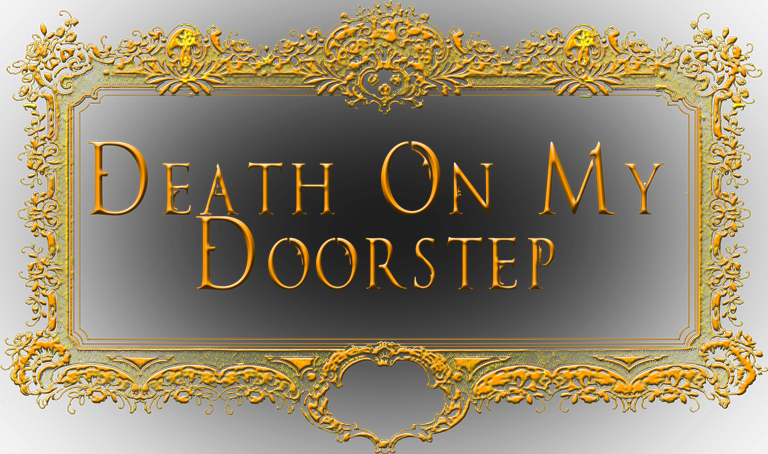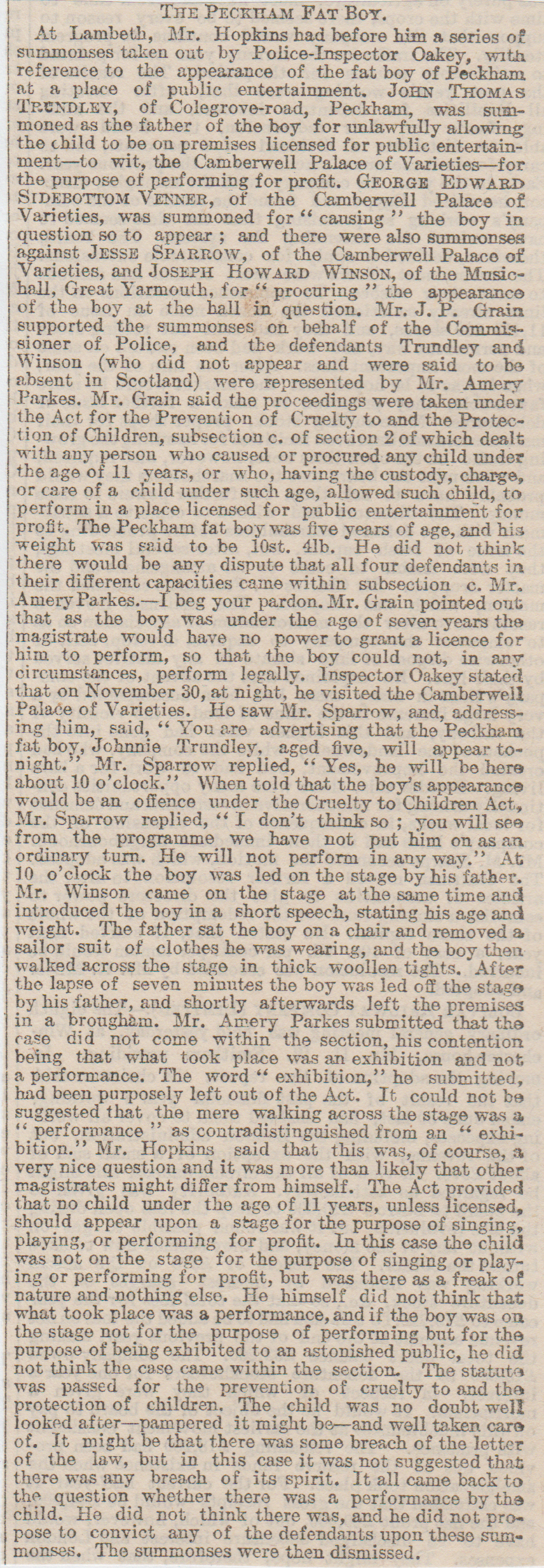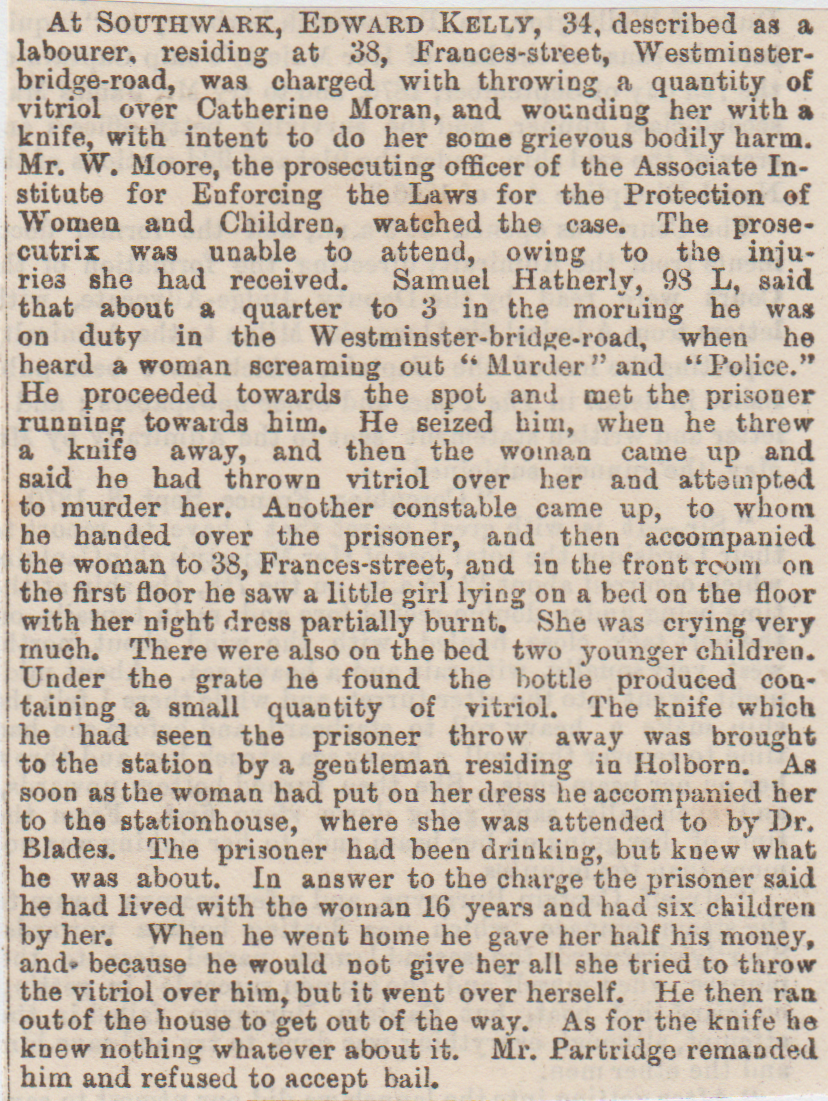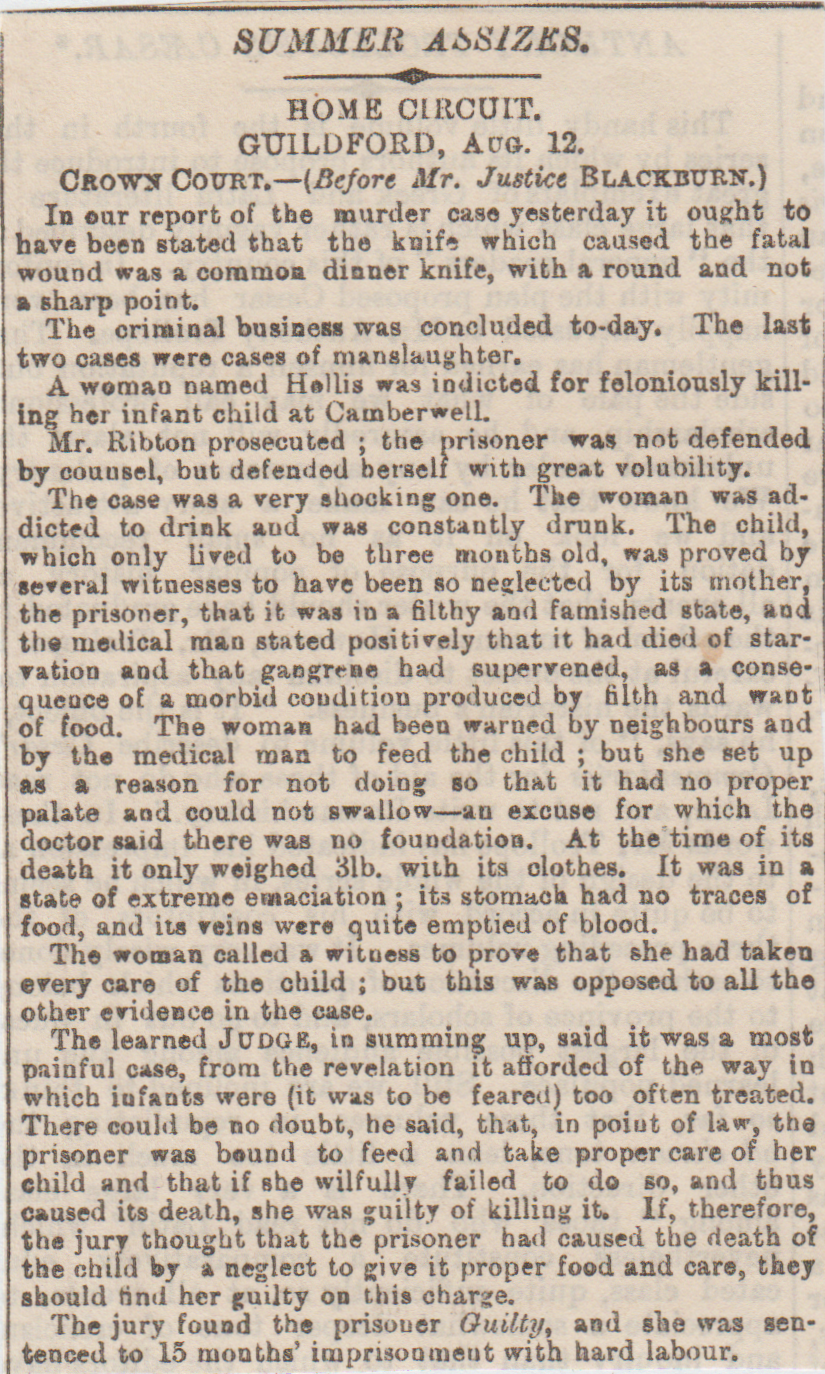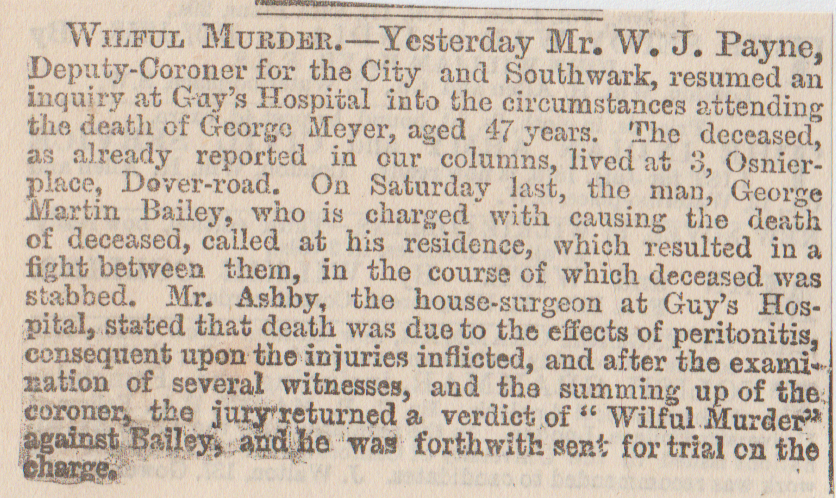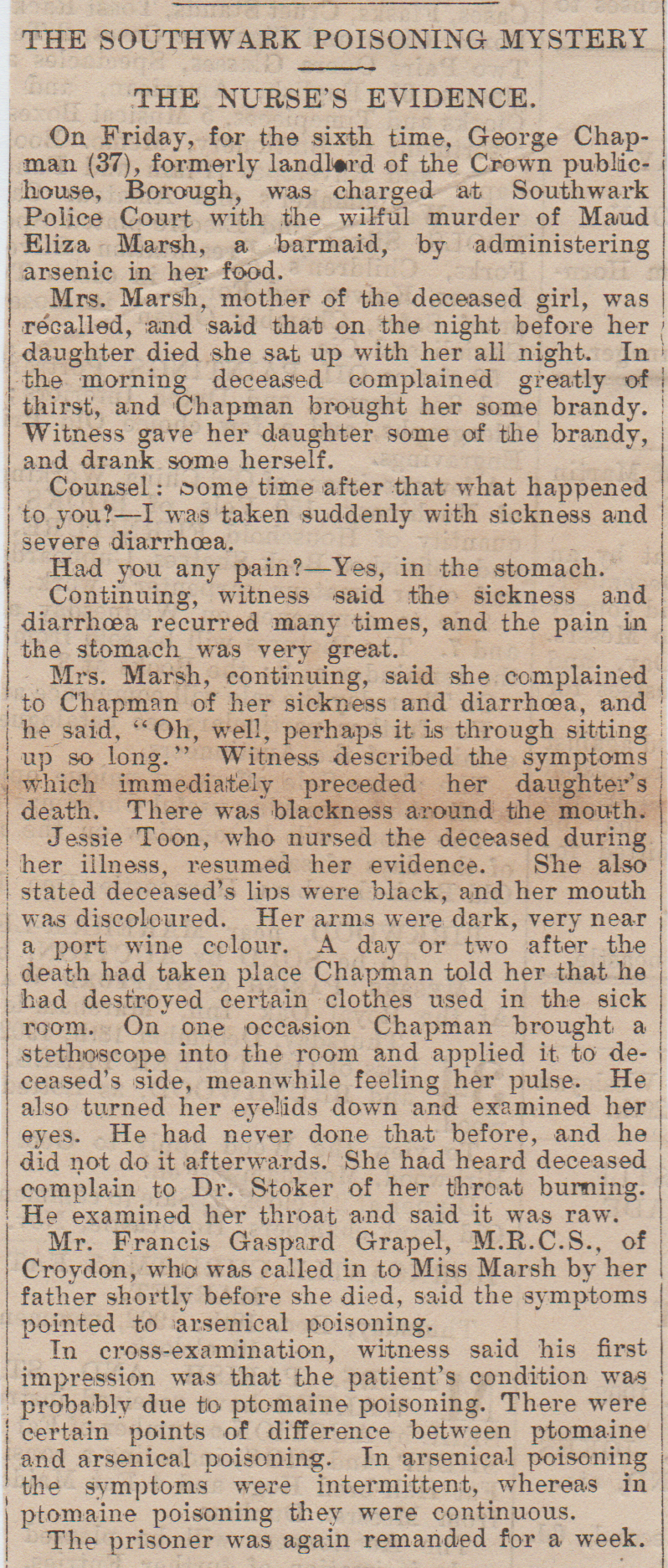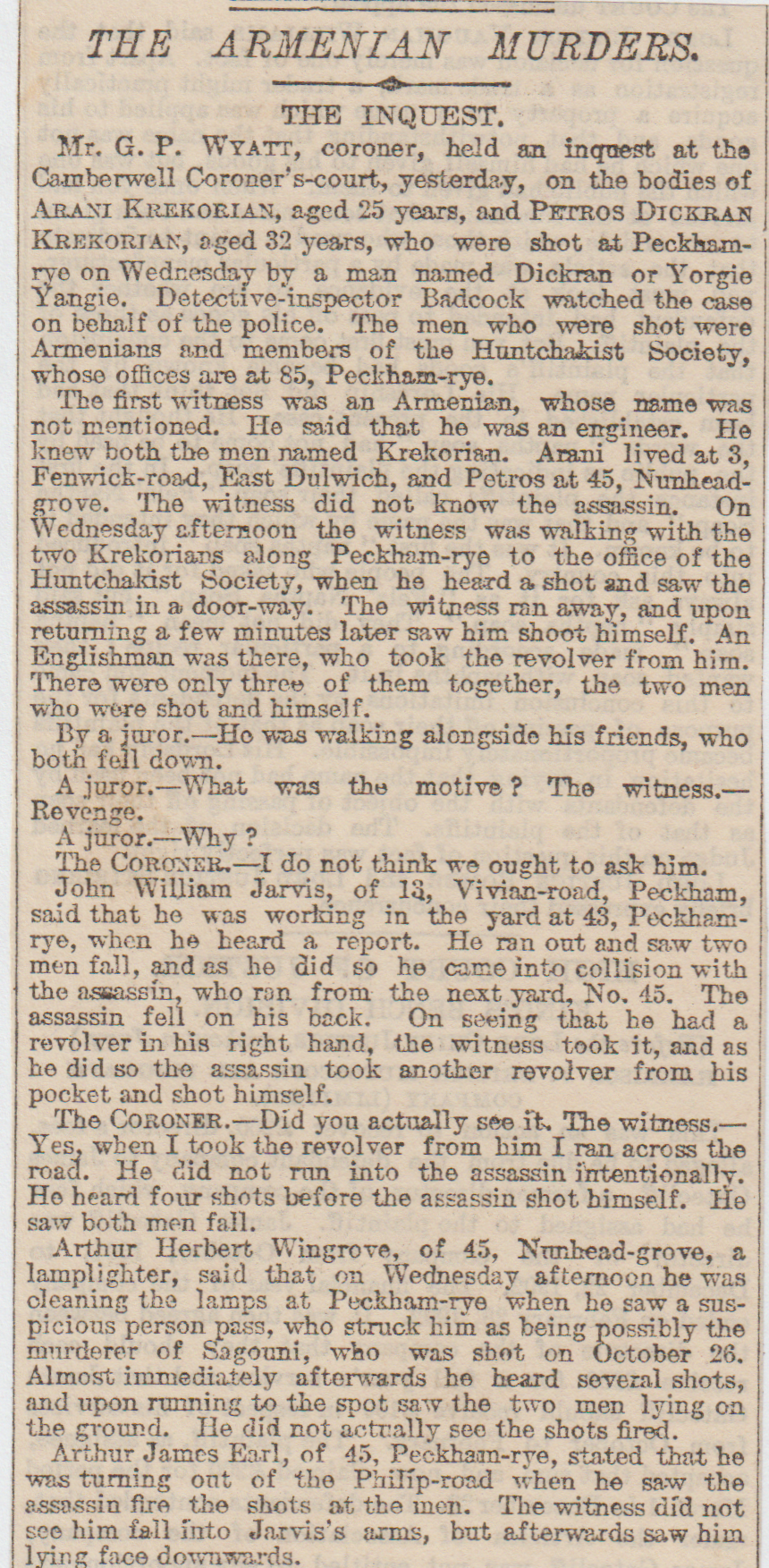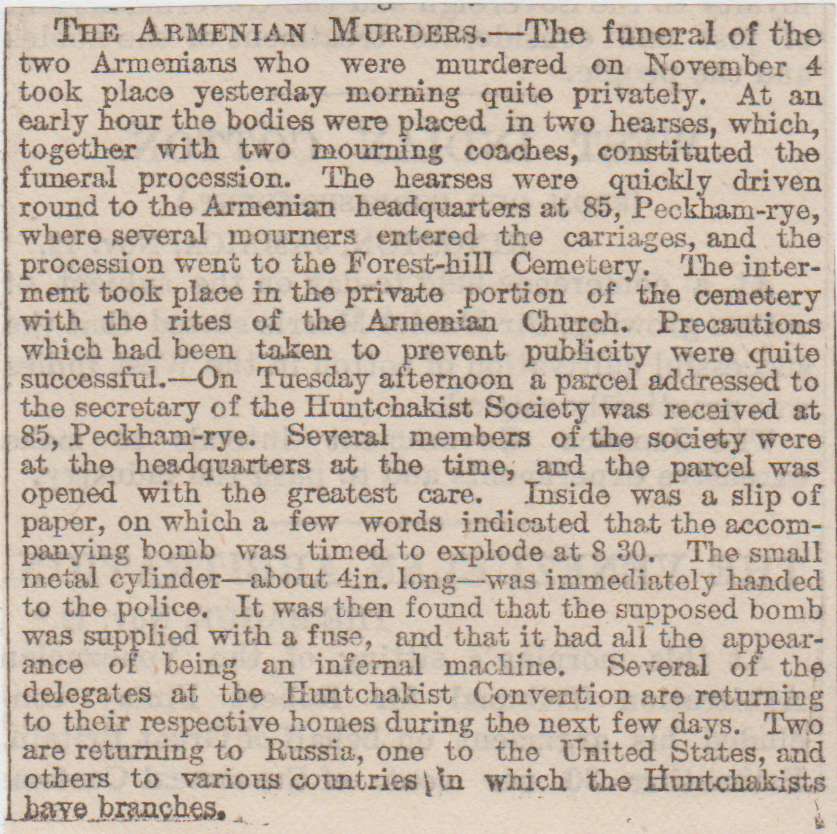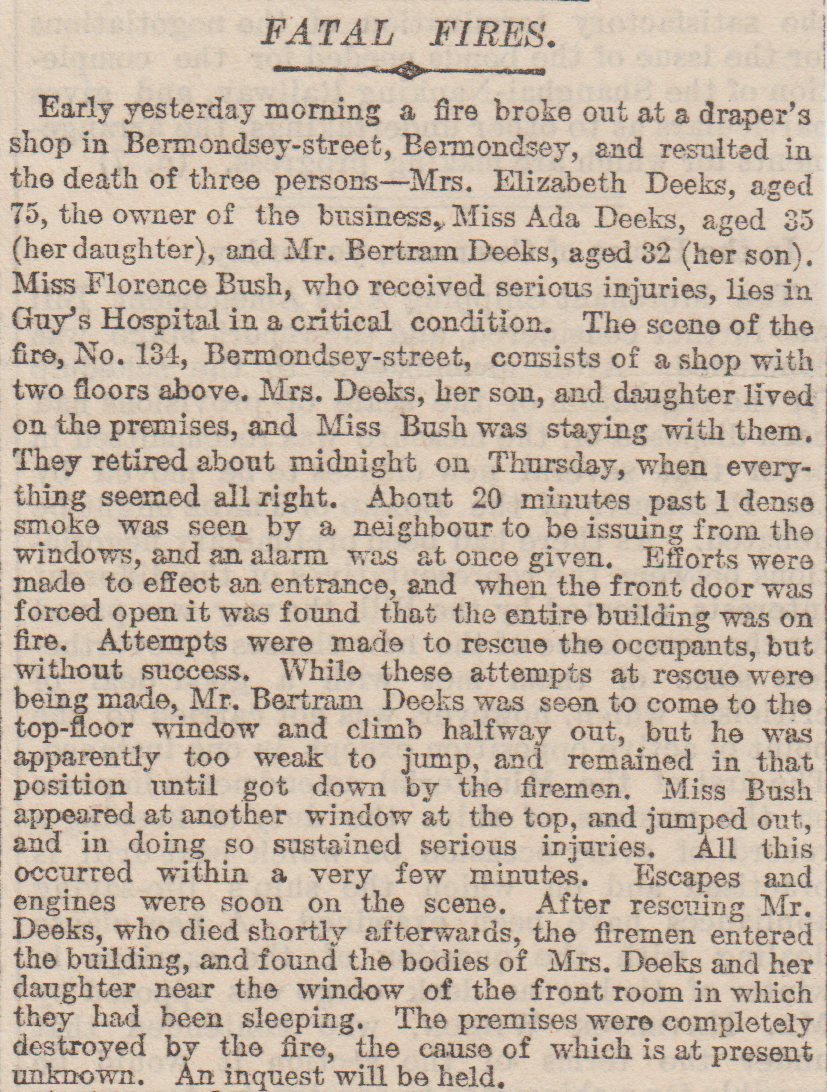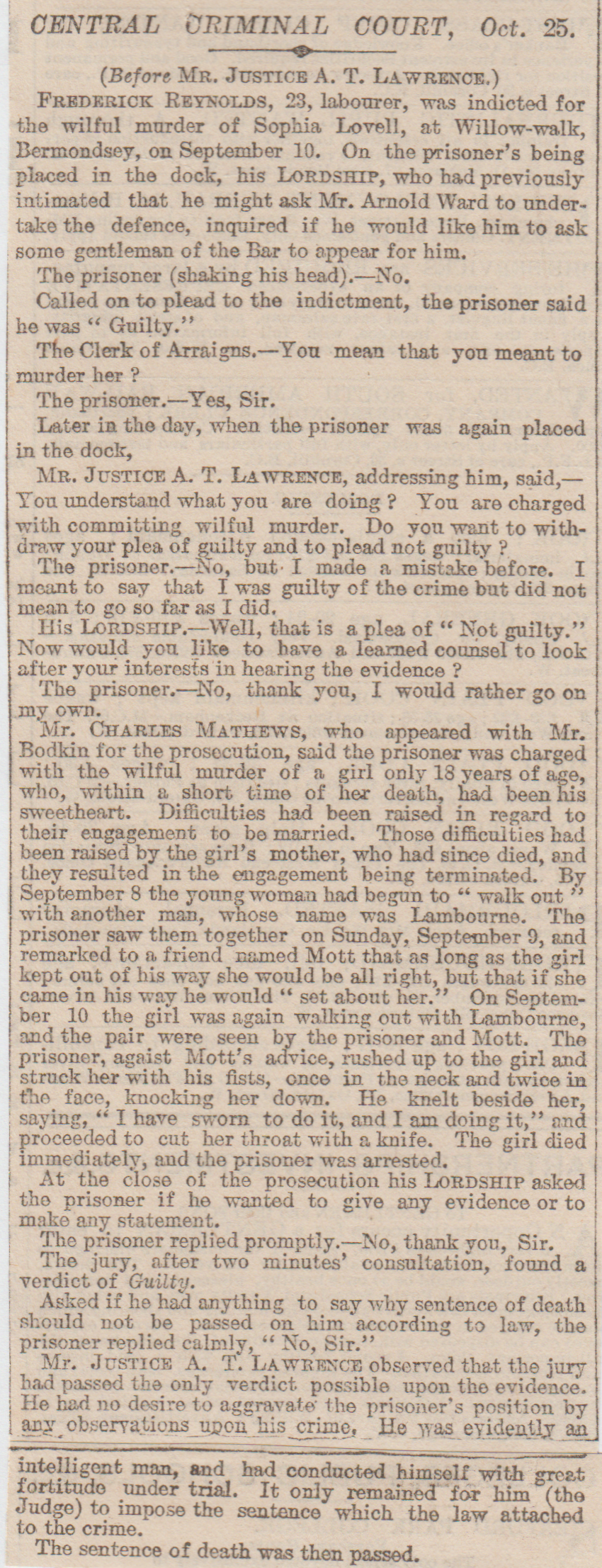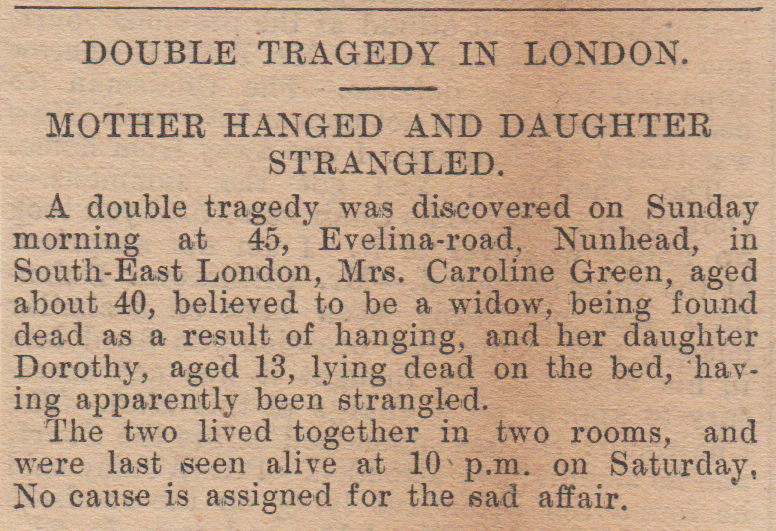1/ Brockwell Park, Dulwich, August 1885 (Child’s Body in Pond)
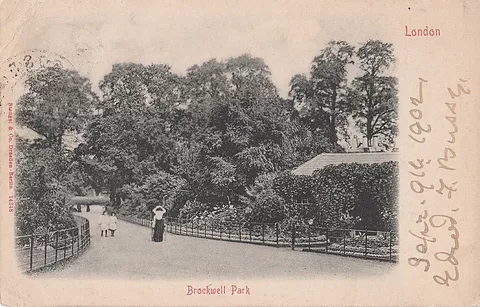
Two lads were fishing in the pond at Brockwell Park when they decided to move to another part due to not catching any fish. On doing so Frank Warner Allen and Edward Turner Lloyd spotted the tiny corpse of a male child. It was on a piece of calico and nearby were a copy of the “Daily News” and some brown paper. They found P.C. George Cooke 494 W Division, and told him of their find. The body was fished out and taken to the local police station. The child was a healthy eight-pounder, but had bite marks on its neck, probably from a dog. It was thirty yards from the main road so therefore nobody could have slung the little bairn over the fence. The verdict “Found Dead”.
2/ Kennington Park/Camberwell? May 1877 (Across the road from The Oval Cricket Ground, near Oval Station)
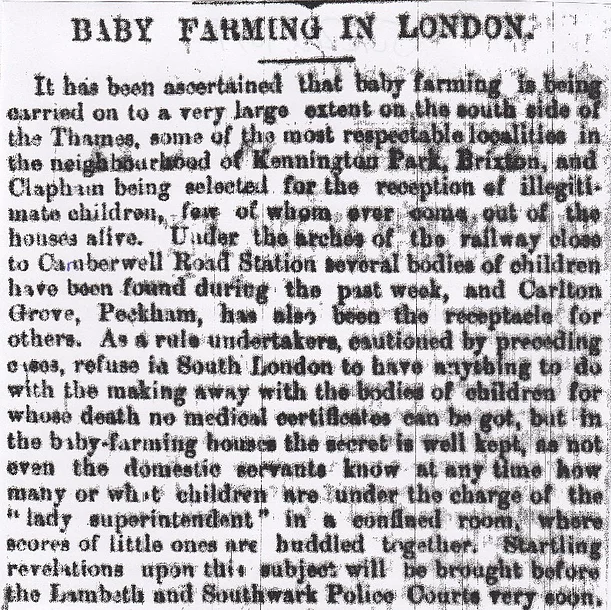
3/ Selborne Road Suicide, Camberwell, (Religious Mania) November 1890
Elizabeth Horne aged sixty-seven, residing in Selborne Road, Camberwell was described by her husband, William, as having suffered from religious mania. The daughter, Sarah, said that her father went out and left her mother doing the washing, then she left the kitchen. After a few minutes, she went upstairs to get her mother and found her suspended by a strap from a hat peg. An overturned chair was next to her feet. She was cut down, but unfortunately, she had already expired.
4/ Southwark Workhouse Suicide, May 1870
A man named Driscoll was discovered in a workhouse in Southwark, lying on a bed, with his stomach slashed open. Driscoll had thrust the knife into his stomach then dragged it across to the other side, leaving a gaping wound and entrails and intestines visible. They tried to save him but the injuries were too severe and he passed away shortly after.
5/ Rotherhithe Dock, (Ancient Body in Cargo) January 1878
The body of a female was discovered on board the vessel, Irvine, which is in dry dock at Rotherhithe. This isn’t as sinister as you first think! She was found in the cargo hold, in which had been tons of soda. She is in a state of excellent preservation and its thought that centuries ago in Peru, which is where the cargo is from, an earthquake struck and she is a victim of that.
6/ Southwark, February 1892
The inquest at Southwark touching the death of an old man named Thomas, a seaman, who, while kneeling before his wife’s coffin, pulled out a gun and blew his brains out. (Where did this occur?)
7/ Grange Road Fire, Bermondsey, August 17th, 1885
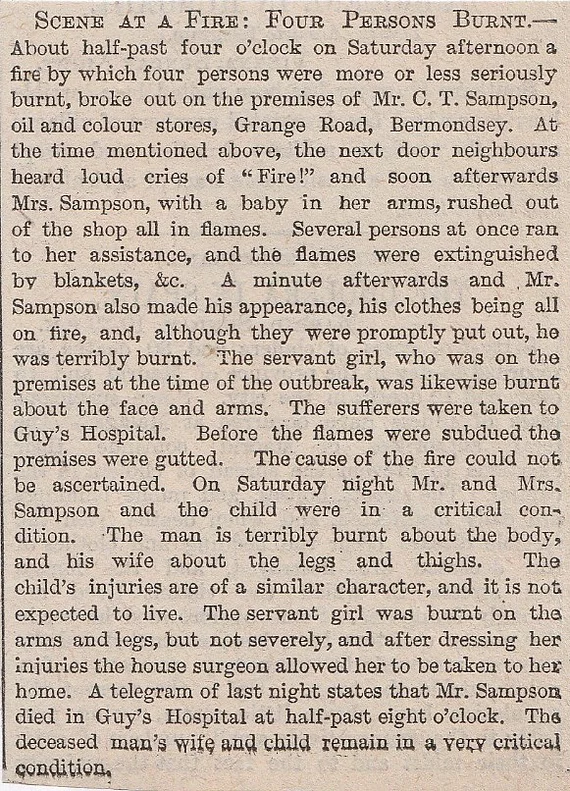
Grange Road, Bermondsey August 18th, 1885
The infant child, Edward Sampson, died at Guy’s Hospital last night from injuries sustained in Saturday’s fire at Bermondsey.
8/ Camberwell New Road, (Actor’s Suicide) December 1910
An actor by the name of Charles Goodhard aged forty-one grabbed a knife from a butcher’s block outside his shop in Camberwell New Road and slashed his own throat with it. A fellow actor, Ernest Leicester, said that he had been acting with him at the Palace Theatre in Camberwell and Goodhard had taken some lodgings in Peckham but had complained of having hallucinations, so the landlady, in her infinite wisdom, told him to leave. Leicester tried to get a doctor’s note to sign him off, on the sick, as he thought he was too ill to go on stage. The butcher, whose shop he committed suicide at, Frank Lomas, said the guy just pulled the knife out of the block and quick as a flash, he slit his throat. It also seems that Goodhard’s hallucinations were getting worse and that the landlady said he was scaring her daughter, so she thought it best that he go somewhere else. Friends had sat up with him the night before, as he had become that bad. The coroner was asked if it could have been delirium tremens but he said it was worse than that. “Suicide during temporary insanity”.
9/ St George’s Cathedral Suicide, Southwark, August 1891 (On St George’s Road, near Imperial War Museum)
A suicide in a church is not amazingly rare, there are quite a few on this website. But fifty-six-year-old Thomas Mason decided to kill himself in St Georges Roman Catholic Cathedral in Southwark. Others have ended their lives in prestigious buildings such as St Paul’s Cathedral, Milan Cathedral and Notre Dame in Paris. I think it’s down to “if I’m going to kill myself, I’ll make it spectacular and memorable to the local population. Also in a religious building, you’re nearer to God and have more chance of going to Heaven, despite the sin of suicide. That’s what I think! Anyway back to Mason. His housekeeper, Elizabeth Tonbridge, who lived with him at Hercules road in Lambeth, said his health was getting worse and had been unemployed for a time and was clearly depressed. He sold pieces of furniture to get by, but then began to hit the bottle and had threatened suicide a couple of years ago. He told her that he was off to sell the rest of his furniture and wouldn’t be out too long. He left a note, with “Liz” on it. The note read :
“Dear Liz- Do not worry. You have been good and kind to me. I wish you had not been so good and attentive to me, when Dr Lowe gave me up. It was you who saved me with your kindness and attention, day and night. I wish you had now let me die. May God reward you for your greatest kindness to me. I know you have kept me since November, and spent all your money on me. That scoundrel- has not only caused me to take my life but has also caused you to lose a good situation. May God bless you is my last prayer. Let the parish bury me. I have written a letter to the police. Also, forward my letter to Bishop Butt.”
The Coroner received a note addressed to him and it went as follows: “To the Coroner- Please do not question Miss Tonbridge, as she is suffering from a weak heart, and it may prove injurious to her. I have taken my own life, as I am tired of it.”
Another letter read:- “Please to break this gently at my residence. I have persevered and tried to get employment, but my endeavours have proved unsuccessful”.
The caretaker at the cathedral, Mrs Emma Murray, heard a crash on Friday evening, then going to one of the side chapels saw Mason lying on the altar steps, quite dead, with the revolver was close by.
10/ Barratt Road Murder/Suicide, Nunhead, June 1885
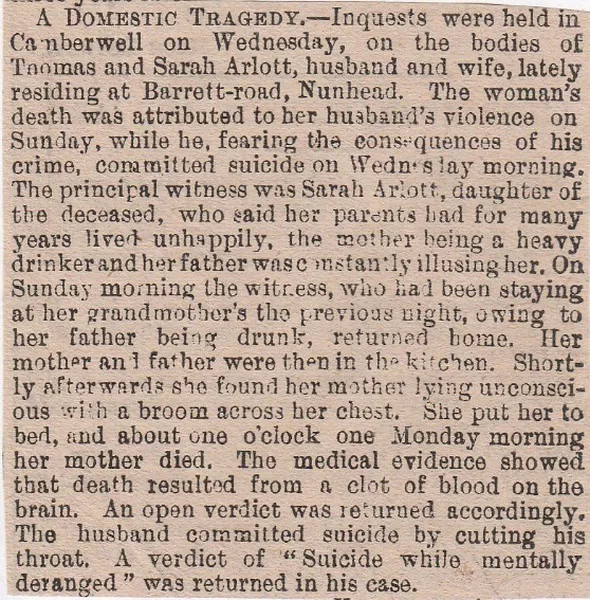
11/ Elephant and Castle Child Murder, May 1908
Six and a half year old, Marie Ellen Bailes of Prebend Street, Islington was murdered and her body was found by the lavatory attendant in St George’s Road, Elephant And Castle on the 30th of May. It was found wrapped in a parcel and police say they are currently making inquiries, but has to be treated as murder against person or persons unknown.
12/ Borough, February 1894 (Suicides Weird Letter)
Alfred Austin aged forty-two, who kept a coffee-house at Greenwich Market, shot himself while in a cab on the High Street, Borough. He had left a couple of letters behind, one to his missus and one to the coroner. His wife’s letter read:
“Dear Ruth- If my luck continues like it has been for the last seven years, it means bringing you to poverty. There I draw the line, and what I am about to do is for the best. Dear old Tom and his wife will cheer you up all they can. I want you to back this double event, twenty shillings each way. Aborigine (Lincoln) and Ardcarn (Liverpool). Goodbye and Good Luck-A.Austin”.
The coroner’s letter went like this: “Mr Carttar, Coroner- Dear Sir, For pity’s sake, don’t trouble my wife to attend the inquest. Having served on many inquests I know the custom. The shock will be bad enough without making it penetrate, for a better woman never trod God’s earth. Kindly oblige yours truly-A. Austin”.
13/ Surrey Canal, Camberwell, April 1885 (Death in Lime-Kiln)

14/ Camberwell New Road, (Tram Fatality) March 1899
A six-year-old boy named Albert Jones was crossing the Camberwell New Road on his way out of school when he was run over by a tramcar. He was badly mangled, as he was caught between the brake and wheel of the tram, then rushed off to St Thomas’s Hospital, but was dead on arrival.
15/ Dulwich Wood Suicide, September 1860
A labourer was walking through Dulwich Wood early one morning, when he came across the body of a man hanging from a rope, attached a tree branch. He ran to get help and the corpse was cut down. The medic who arrived said that he had been dead for quite a while and it is supposed that he fastened the rope, then threw himself off the tree branch. He was about sixty-years-old.
16/ Southwark Skeletons, July 1894
While some workmen were digging out the foundations for a new school in Artillery Row in Southwark, they stumbled across four coffins with the skeletons of four adults in them. The police were informed and they were taken to the mortuary. (Was it an old burial ground/churchyard?)
17/ Camberwell/Walworth Road, January 1885
Mr Bradford of Wingrave Street in Camberwell, whose mysterious disappearance has excited much inquiry, was found on Friday in Walworth Road and induced to go home. On Saturday morning he jumped from his bedroom window, impaling his foot on the railing and injuring his head. He now lies in a dying condition.
18/ Surrey Canal, near Old Kent Road Bridge, June 1889 (Four Drowned)
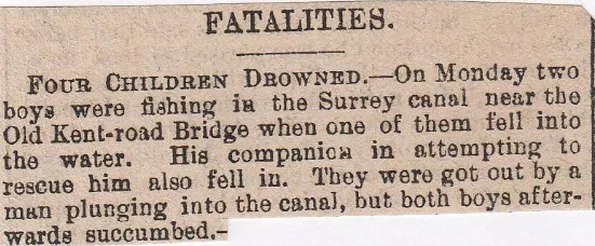
19/ London Bridge Railway Station, April 1871 (Next to London Dungeon on Tooley Street)
A child’s corpse covered in lime was found at London Bridge Station on the South-Western Railway. One of the closets was being repaired and when the seat was removed, they found the infants remains. The surgeon doing the post-mortem stated it had been dead for several months, and where it was found, the seat had to be lifted off then nailed down.
20/ London Bridge Station, (Boy’s Body Found) September 1869
A lamp-boy went into the ladies waiting-room to light the lamps and saw the floor soaked in blood. He called Baylis the porter and Mr Jones the station-master, also Inspector Haycock, they searched the area. In one W.C. they came across the body of a full-grown boy, with the head fixed at the bottom of the pan. It was removed and was still warm. A woman was seen in the vicinity and checking the tickets collected during this time, only one, from Greenwich, was collected. (Did she kill the child?)
21/ The Peckham Fat Boy, December 1903.
22/ Eugene Road Explosion Victim, April 30th, 1885
Mrs Rebecca Ewington aged forty-two, one of the women injured in the explosion which occurred at Eugene Street, Rotherhithe on the night of Monday, April 20th, was removed to Guy’s Hospital where she had both her legs amputated. She died on Tuesday morning. All the other persons injured in the explosion are progressing favourably.
23/ Eugene Road Explosion Inquest, May 1885 (See above)
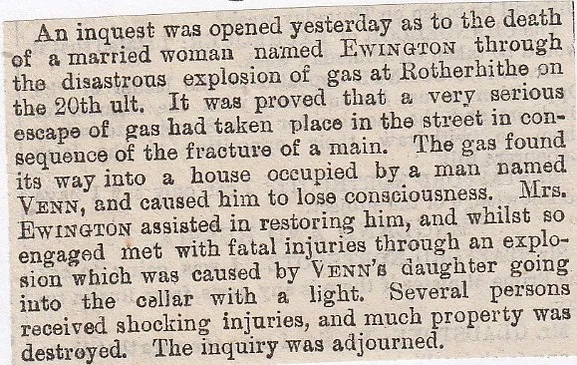
24/ Great George Street, Bermondsey, (Horrific Death) August 1851
A dreadful accident occurred at the premises of Mr Keatley, soap manufacturer, Great George Street in Bermondsey New Town. A twenty-four-year-old workman named John Murphy was crossing a plank of wood on the side of the copper when he lost his balance and fell headlong into the boiling liquid. He was taken out and taken to Guy’s Hospital, but the chances of him making it are slim.
25/ Grand Surrey Canal Drowning, July 1885
A lad aged thirteen named Sampson Johnson was drowned at Camberwell on Sunday evening when bathing in the Grand Surrey Canal. The deceased said when entering the water, that he could swim very well.
26/ Camberwell Empire Murder, April 1910 (Murder in Music-Hall)
Thomas William Jesshope aged thirty-two, who was a fireman by profession, was found guilty of murdering John Healey, the Camberwell Empire’s stage carpenter, at that place, by stabbing him. Jesshope was fired from his job at the Empire and Healey took over his position. Jesshope sought revenge for this and he went and stabbed him in the pit of the Camberwell Empire, just after a performance on the Easter Monday. Defence plea was one of insanity, (and again) epilepsy running in the family, plus domestic problems, drove him into a state of rage and he couldn’t stop himself. The defendant said he remembered nothing about the stabbing and only remembered being in a police station. (Was he found guilty or did he get off lightly?)
27/ Waterloo Road Murder, (Lambeth/Southwark) February 1895
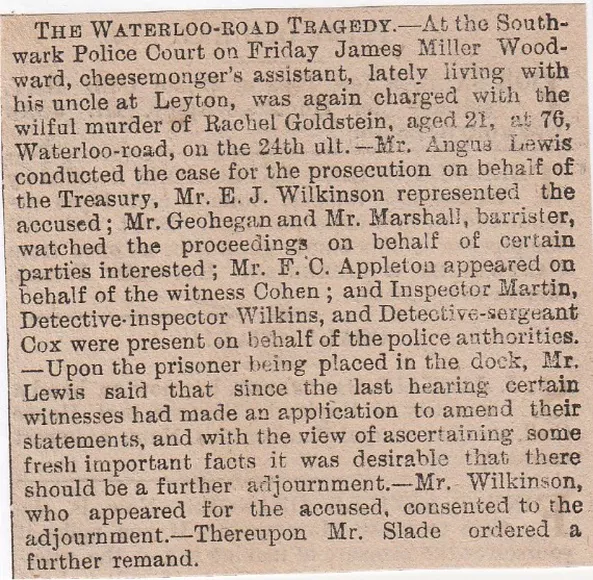
28/ Wyndham Road, Camberwell. (Murder/Suicide) June 1878
A man named Hale shot his wife with a revolver at 9-30 a.m. one morning, then turned the gun on himself and blew his brains out. The sixty-five-year-old, living with his missus on Westhall Road, off Wyndham Road, was whisked off to the hospital where he lies at death’s door. The motive for the murder/suicide is not known.
29/ St Saviour’s Dock, Southwark. January 1858 (Man/Woman Suicide)
The body of an unknown male was discovered near London Bridge, after being seen to jump into the Thames near St Saviours Dock. He was five feet nine inches tall, dark complexion, about thirty odd and smartly dressed. He had a note about his person, saying: “May God bless you, my dear Maria, and your children, forever. Adieu. -J.W.”
The other suicide was a female who drowned herself near Millbank. She was thirty-ish, black skirt, black velvet jacket and the under-linen had a tag marked “M.S.No 5”. Nothing else is known, so she remains a Jane Doe for the time being.
30/ Duke Street, near London Bridge. May 1868
The governor of Ayr Gaol, Robert Sutherland killed himself in the Hand-in-Hand beer-shop in Duke Street (Duke Street Hill is still there!) not a million miles away from London Bridge. He fobbed his missus off by saying that he was going to Edinburgh and instead got a train all the way down to London, then got a room at the Hand-in-Hand. When he never appeared on Sunday, they forced the door open and found Sutherland on the floor with his head on a pillow, and an upturned basin next to him, from which blood had flowed onto the floor. He had the razor nearby and over £37 in his pockets, which was a phenomenal amount in those days. A couple of letters by Sutherland explained that he suffering mental problems and decided to kill himself as a last resort.
31/ Bankside, Southwark, July 1895 (Watching a Boy Drown- Case of Genovese Syndrome?)

32/ Finlay Street, Peckham, March 1899 (Suicide-Self-Immolation)
Eliza Burton aged fourteen, residing with her parents at 18, Finlay Street, Peckham, committed suicide by self-immolating. He father heard her screams coming from the scullery so he rushed to see what was wrong. He was met with his daughter in a ball of flames. She had got some paraffin and soaked her underclothes and then torched herself. The father afterwards said that she had nicked some money off one the girls she worked with at the laundry and this preyed on her mind.
33/ Walworth Road Station, (Fatality) February 1866
A dreadful accident occurred near to the Walworth Road Station, which caused a man’s death. Workmen were involved in the construction work of a double line and this was a day/night operation so they could finish the job quicker. A navvy working on it was knocked down, with the wheels cutting and mangling his body. He died on the spot.
34/ Camberwell Baby-Farming, October 1873
For quite a while now the corpses of dead children have been packed up in South London, all having severe cuts and bruises on their bodies. One was found at County Terrace, Camberwell Road, and police believe that an establishment similar to the one that Margaret Walters kept is somewhere in the area. (Walters was infamous for baby farming, and thought to have killed nineteen kids and profited handsomely from doing so)
35/ Elephant and Castle, (Fatal Cab Accident) August 1885

36/ Horselydown, (Suicide Over Pet Dog) September 1869
This is a sad little tale of a woman whose conscience got the better of her. The couple, a German watchmaker and his wife living in Camberwell, were extremely hard up so they looked at where they could make a saving. The pet dog was costing seven pence a week so they decided to drown the hound. The woman went to Southwark Bridge and lobbed it off. A few days later remorse seems to have suddenly kicked in and she went down to the Thames and dived in. Her body was found floating at Horselydown.
37/ Camberwell Gate, (Fireman Suicide) November 1900
Fireman C.F.B. Garside of the Met Fire Brigade, who worked from the Old Kent Road Fire Station, hung himself from the fire escape “duty” box at Camberwell Gate. A fellow fireman found him and cut him down. He was moved from the drill class a few weeks ago and has only been in the Fire Brigade a short while. The motive for his suicide could be the stress of the job.
38/ Peckham Manslaughter, June 1895
At the Old Bailey David Harboy, who was yesterday found guilty of the manslaughter of his wife on the 5th at Peckham, this morning was sentenced by Mr Justice Wright to five years penal servitude, the sentence being made light because of great provocation and the prisoner having sunstroke in India.
39/ Gravel Lane, Southwark, November 1847
Nineteen-year-old John Ward was deeply fond of a woman, but she died suddenly. Ward seemed to go into his shell and a few days after her death he failed to turn up to work, instead was found at home in Gravel Lane writhing around in agony from the arsenic he had taken. A short note read: “I cannot live in this world any longer without my dear Elizabeth, so place me in the same grave with her- John Ward”.
40/ Bermondsey (?) March 1899

41/ Peckham Rye, (Children’s Bodies) June 1868
Three children’s bodies were found by dogs in a ditch at Troy-town, Peckham Rye. There was one boy and two girls and they were in an appalling condition due to the action of quicklime. The boy’s skull was fractured and he only weighed six pounds and was thirty inches tall. A witness had seen a butcher’s boy throwing something from a basket into that ditch at some point, but he was not questioned. Insufficient evidence was the jury’s conclusion and let the police continue the investigation.
42/ Dulwich Mutilation, March 1879
Henry Wheatley, while walking along the tow-path near Barnes Terrace saw a large box floating on the surface. A quick look in the box revealed its contents to be human remains wrapped in brown paper and packed together. The doctor who examined them said it was clearly a case of murder and estimated that the victim was a female in her twenties. The portions of the body were the upper part of the chest, right lung, and right shoulder joint, attached to the body and chest. The left upper arm had been removed from the shoulder. A piece of the right leg which had been severed below the hip joint, this had been hacked off at the knee. The medical examination also revealed that the cutting tool was probably a chopper and was blunt. Police received a missing persons report of a German girl who worked as a dairymaid in East Sheen, who left for another job and was to have been met at Waterloo Station by the butler of her new employers family but never turned up.
43/ Kennington Murderer, May 1899 (Wandsworth Gaol Hanging)

44/ Wyndham Road, Camberwell October 1851 (Triple Filicide/Suicide)
It was actually on Queen’s Place off Wyndham Road in Camberwell where a father, named Anthony Fawcett (43), sadistically murdered his three children by slitting their throats, then committing suicide in the same way. He is a stranger to the neighbourhood and he had just gone into business at Stockham’s grocer shop on the corner of Queen’s Place. He had been there for a few days and started to complain to his missus about the lack of customer’s and how he thought he had been diddled into buying the shop. The children were Emily aged six-and-a-half-years, Frederick only one and a half years old and Mary Ann who is in a pitiful state, but may pull through. He was found in the garden and after medical assistance to try and close up his laceration, he died soon after.
45/ High Street, Peckham, August 1903 (Boiling Tar Accident)
The roads around here are in connection with the electrifying of the tramways and among the appliances used by contractors is a massive cauldron for boiling tar. It is on the back of a horse-drawn vehicle, but on this occasion, it tipped over and the contents, which weighed over a ton, spilt onto the pavement. Four youngsters were in the vicinity and two escaped but the other two took the brunt of it and were horrendously scalded and they died on the way to the hospital. Mr Valentine’s newsagents was covered in a black mass and he closed the premises immediately.
46/ Bermondsey, (Inheritance Hoax) March 1895
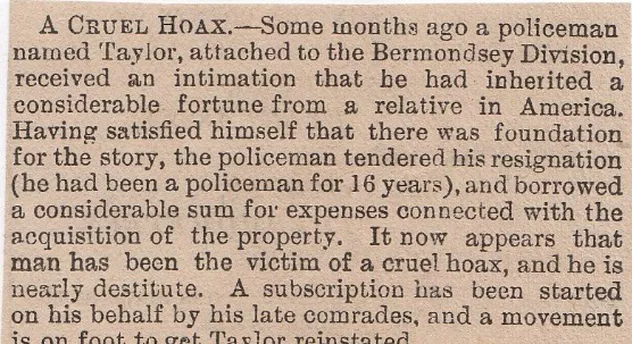
47/ Walworth, August 1905 (Father Slays Children)
Henry Walter Popple was a middle-aged unemployed coachman living from hand to mouth with his missus and three daughters at No 2, Sandringham Buildings, Chatham Place. He went upstairs to the girls’ bedroom and killed four and a half-year-old Violet Selina, then two-year-old Gladys Dorothy, by slitting their throats with a razor. Eight-year-old Ada Pauline was badly wounded in the attack but lies in a precarious condition in hospital. Then to end it all he cut his own throat but was prevented from doing it fatally by policemen who overpowered him. The neighbour heard shrieks of “Murder!” and got a copper to go over to the property, where he found the two children dead and one alive but seriously wounded. The wife was in a hysterical state.
48/ Claren Place, Camberwell, January 1853
This tells you in a nutshell what life was like in Victorian slum areas of London. Eliza Pallinger aged only fifteen and living at No 3, Claren Place in Camberwell, was charged with the murder of her newly-born infant. The supposed father of this child, a forty-year-old named James Brown, killed himself by cutting his throat. A forty-year-old and a fifteen-year-old today would only come into to contact if he was trawling the internet, but forgive me if I’m wrong, the age of consent was thirteen or fourteen.
49/ Grange Road, Bermondsey, September 1885 (Girl’s Heroism)
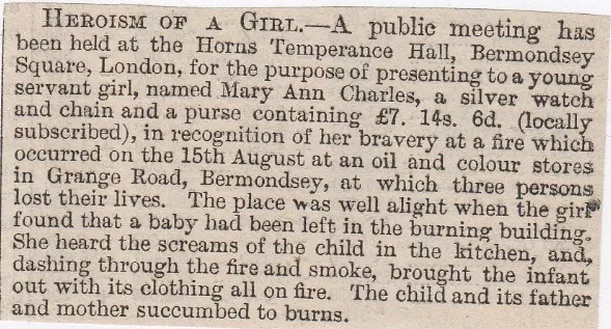
50/ Swan Lane, Rotherhithe, May 1897 (Child Neglect)
An Inspector Chown from the N.S.P.C.C., went to No 51, Swan Lane in Rotherhithe after neighbours had complained about the way the kids were treated. In a windowless cellar, he found a two-year-old boy sitting upon earth. His eyes had crusted over with sores and he was in a filthy condition. Sometime later the child’s mother, Mary Ann Foster, turned up rat-arsed. Foster had been imprisoned for two months about two years ago, for neglecting the same kiddy. This time she got four months hard labour.
51/ Old Kent Road, (Child Remains) August 1878
After an anonymous tip-off, a police-officer went to Charles Mummery’s shop on the Old Kent Road to follow-up the lead he had been given. As soon as he walked in the foul smell caught his attention and the stench was coming from under the floor. Mummery went downstairs and fetched up a box, which, when opened, contained the bodies of several children submerged in quicklime. Mummery said it had been there for months and police are now investigating the matter and have buried them properly.
52/ Southwark Bridge Road, (Skeletal Remains of 50) July 1896
While some builders and workmen were excavating at No 52, Southwark Bridge Road, a horrific discovery was made. William Roffey, a bricklayer, came across an estimated fifty skulls and loads of human bones to go with them. The bodies had been piled on top of each other, sort of like a mass-grave and the site covered several square yards. This is still there! Next door to Nelson’s (corner of Union Street and across the road from Island Cafe, under the railway bridge)- Google Maps 2016
53/ Camberwell, June 1889 (Mesmerised Into Giving Money Away)
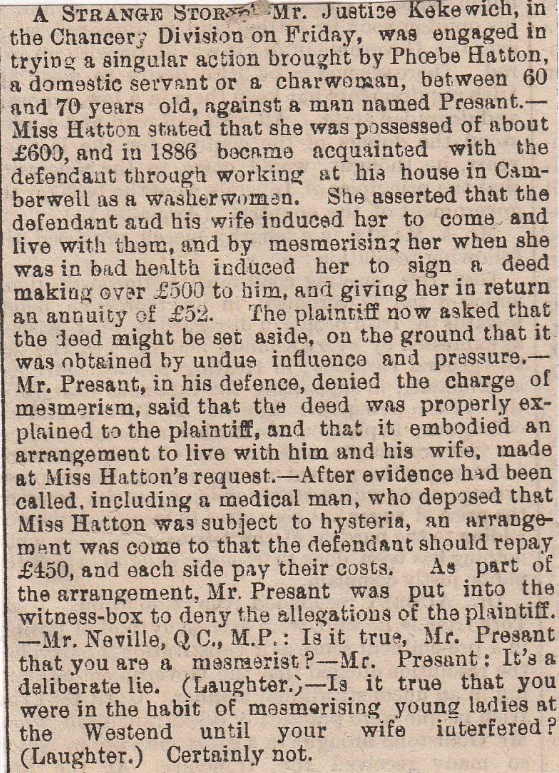
54/ Webb Street Roman Catholic Church, Bermondsey, October 1863 (Human Remains)
While engaged in removing fixtures and fittings in Webb Street Roman Catholic Church, prior to its demolition for the railway enlargement, the workmen discovered, between the ceiling and roof, a pile of human bones thought to be those of an adult female. When they were examined, bizarrely, on one bone was written “Mr Phillips”, and another bore the inscription “Four guineas, the course of lectures”. It can be said that Mr Phillips was a medical student who had placed the remains in the church to get rid of them. The church itself was used as a “theatre of anatomy” many moons ago, so they abandoned the thought of an inquest and instead buried the bones in a local churchyard.
55/ Grand Surrey Canal/Coleman Street, Camberwell, August 1858 (Murder/Suicide Attempt)
Here’s a sad little story! A bloke named Thomas Wilkinson who lived in Coleman Street in Camberwell with his missus and children, apparently quite happily. Mrs Wilkinson goes off to the coast for a short break and while she was there, she got word that her husband was “playing away” and seeing other female company. She rushed back and after getting confirmation from neighbours about her husband’s extra-marital affairs, she took hold of the baby boy and leapt into the Grand Surrey Canal with him. A passer-by jumped in to save them, but Mrs Wilkinson kept screaming “Let me drown”. The guy managed to save her, but the little boy drowned.
56/ Peckham House Lunatic Asylum, (Lunatics Eating Habit) June 1852
I just assumed that because it had Peckham in the name, it was in Peckham itself, so I could be wrong. This is about a patient there and his peculiar eating habits. When he died they cut him open and found the following items of metalwork and cutlery in his stomach. Spoons and other items that weighed over two pounds, three spoon handles, nine nails, half a heel of a shoe, a two and a half inch screw, four pebbles (probably a dessert!), a metal button, plus other tiny knick-knacks.
57/ Queen’s Buildings, Southwark, July 1895
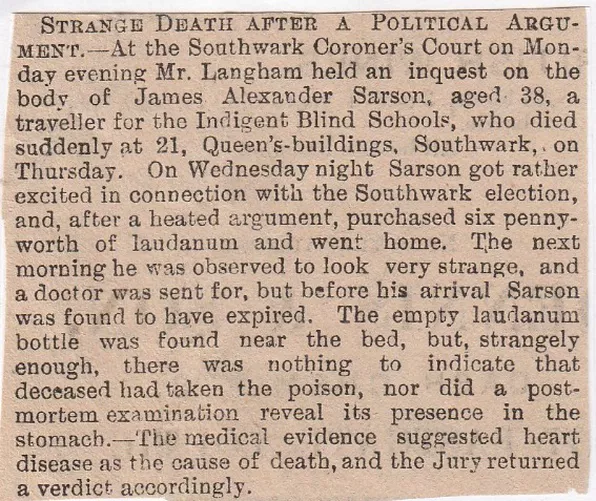
58/ Vassall Road, June 1901 (Eccentric Vicar’s Death). Says Brixton but now in Camberwell
The Reverend George Bradshaw died in a fire at 27, Vassall Road, Brixton, and is thought to have been started by him. He would barricade himself in his room and see no-one. At the inquest, a witness was asked if he kept paraffin in his bedroom and he replied “no”. Asked if he got any mail, he replied: “very rarely”. Literally, the clergyman was a hermit. His charred body was found on the bed, as though he’d been suffocated while on there. He had retired from the clergy some years ago and this was chalked down as an “Accidental Death”.
59/ Addington Square, Camberwell, (Teenage Suicide) June 1832
A fifteen-year-old boy has a barney with his mother and commits suicide. Thomas Bennett aged fifteen, of Edmond Street in Camberwell, was the only man in the house and he was the only earning any cash to keep the family going. His father had gone off to America and left his wife and five kids to fend for themselves. Thomas got a job at the public baths in Addington Square for seven shillings a week. He had an argument with his Mum and he stormed off to work telling her “that she would never see him again”. While at the Baths he wrote on the wall “Throw your drags into the deep, You’ll find your son Tom fast asleep”. He then drowned himself in the reservoir of the Baths.
60/ Old Kent Road Stabbing, August 1885

61/ Horsleydown Suicide, November 1860 (Opposite the Tower of London)
Ann Clark was a young, good-looking woman who still grieved for her husband, enough to commit suicide. Her body was found near the Tower of London in the Thames. Her brother said that her husband, David Clark, had died about a year ago and that they had three children together and that ever since his death she’d been in a despondent mood. On the 22nd of October, she told her mother she off out to look for needlework to keep some money coming into the household. That was the last time anyone saw her alive again.
62/ Camberwell, (Eight Shilling Suicide) September 1865
Fifteen-year-old Sarah Ann Abbott was a servant to Mr Pullinger of Elizabeth Ann Villas, Coal Harbour Lane in Camberwell. The family were going to Epsom to watch the Derby race, when Mrs Pullinger found two sovereigns missing from her bedroom drawer, then discovered the missing coins in Sarah Ann’s possession. Her aunt, Mrs Storer, was sent for, to come and get her thieving niece. Mrs Pullinger didn’t want the police involved but didn’t want her in the house. When asked about the sovereigns she admitted to taking them but said another girl had told her to nick them, whereupon she gave her mistress £1 and 12 shillings back saying she had spent eight shillings. The aunt arrives and Sarah Ann runs upstairs crying her eyes out, then takes a huge gulp of “Burnetts Disinfecting Liquid”. On the way home with her aunt, she began vomiting and had painful stomach cramps and died later on at St Thomas’s Hospital. All over eight shillings!
63/ Union Street, Borough Fatal Fire, May 1885
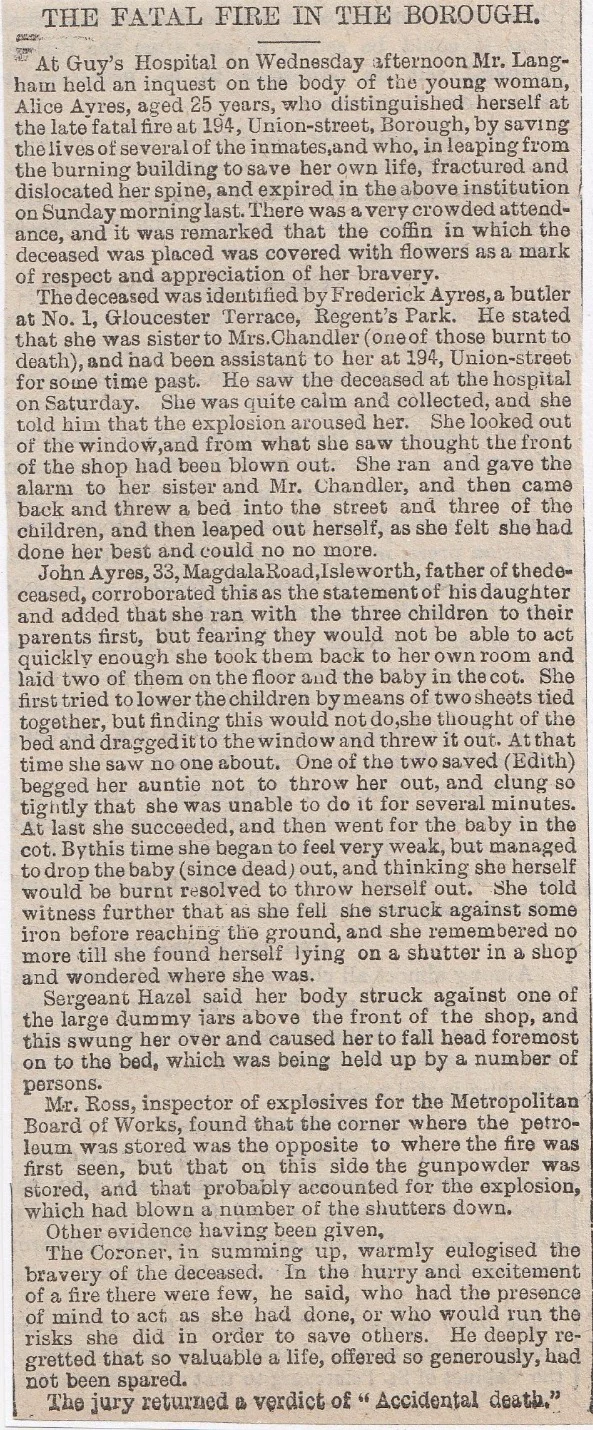
64/ Peckham, September 1900 (Missing Bridegroom)
The village of Heston in Middlesex was the scene of a missing bridegroom, and two weeks later he was found in a house in Kent Lane in Peckham, suffering from phosphorous poisoning. The groom, Charles Hawley, was to wed Alice Chandler, but on the day of the wedding Hawley arrived at the bride’s parents house and slept there. Midway through breakfast he got up and walked out of the house and vanished for the fortnight. Police found a letter on him addressed to the jilted bride. He is in a precarious condition in Miller Hospital in Greenwich.
65/ Darwin Street Fire, Old Kent Road, September 1885
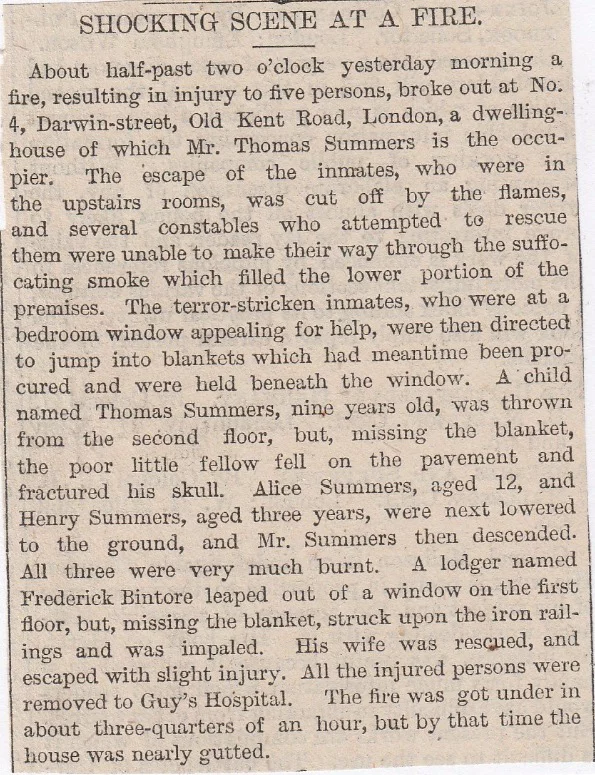
66/ Wildash Road Bride Suicide, Camberwell, January 1888
Twenty-four-year-old Priscilla Moore killed herself at her house in Wildash Road in Camberwell, by cutting her throat with a razor. Mrs Moore had only been married for about three weeks, with the wedding on Boxing Day. Alexander John Moore, the husband, returned home one evening to find the house pitch black. He found his wife upstairs lying partly on the bed and partly on a chair with a huge gash in her throat. She was fully dressed but had taken her boots off. Why, after so short a time being married she did this, is a mystery.
67/ Oakley Street, Waterloo Road, July 1895 (Stabbings)
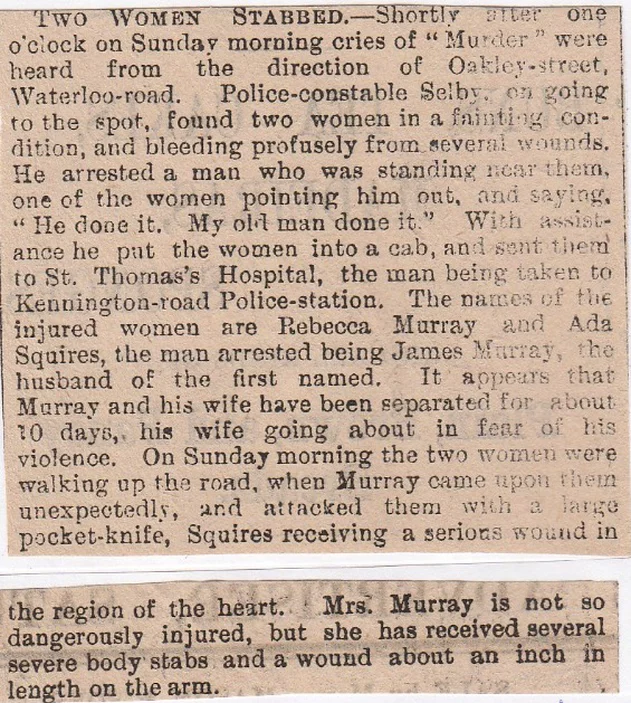
68/ Stantons Wharf, June 1900 (Suicide Diary)
This is a collection of letters written by Charlotte Helen Reeve, twenty-three-years-of-age who was in the service of Mr Cooper, Glenhurst, Clapham Park. These were written to her sister who was working at Hyde Park Gate and they read like this:
“April 29- On the night I post this to you I shall have left here forever, so you will please have my boxes fetched to you, or wherever you like to have them sent. If Mrs Cooper says anything to you about our late butler spare his name, as he is nothing whatever to do with me. He is entirely innocent of the cause of my leaving here. Why I am going I need not say; you can guess. The one who has caused me to go I can’t say, and even if I would it would do no one any good. My only wish is that I could take Clepham (her illegitimate child) with me. He is my only worry now. Oh! if I could only take him with me, but that I can’t do. Bad as I am, I must stop short at murder. If my machine and boxes are pawned, I dare say they will fetch a few shillings- enough to pay for Clepham until they take him into the Union, as that is where he must go, unless I can force myself to take him with me at the last minute”——She then carries on with the following lines——
“Myself, I hope and trust, you will never hear of me again. My body may be found in the river near the docks, or I may go further away than that. I cannot fix on the certain place till the time comes, but I have taken away all the washing-marks and names off all the clothes I wear, so that no one will know me, and nobody will identify me. Better for my sake and all the others. I shall have a black silk ribbon round my neck, with a small gold heart-shaped locket and 22-carat gold wedding ring strung on ….
Don’t let mother know of this. Let her think I am too lazy to write to her. I have not written since January. I have left you a dreadful lot of hard work to do for me, I know; but when it is all over I am sure you must think it is the best thing I could do, and what I ought to have done three years ago, and saved my family all the disgrace of these last three years. Just fancy! My first boy in heaven, my second on earth, and my third in hell with me. How awful to have such a record. Now, for your own sake, and the family’s, don’t scream or faint, or do anything like that when you read this, as I must warn you it is very shocking, but it can’t be helped now. I am not unhappy, but I wish I could go now instead of waiting three weeks.
The next letter is dated May 10th and she goes on about how lonely she is. This one is dated May 14th, and it reads:
“My mind is slowly but surely going. I hope it will last one more week. I wonder if anyone else ever felt as nervous as I do about dying. I am going out tomorrow to finish up the last of my business. Then I shall have nothing else to do but to wait for Monday. I am starving myself this week as much as possible as too be too weak to struggle long in the water, as I dread a slow death more than anything else…..I wish the weather was warmer, then the water would not be as cold. I tried it yesterday and fairly shivered.
Finally, on May 21st, Charlotte ends her letter with her signature- “Goodbye, Clara. Pray for me”
Her body was found off Stantons Wharf (Stantons Wharf is on the Bermondsey side of the Thames, between Tower Bridge and London Bridge) with the ribbon, locket and ring on her.
69/ The Southwark Poisoning Case, November 1902 (George Chapman-The Borough Poisoner)
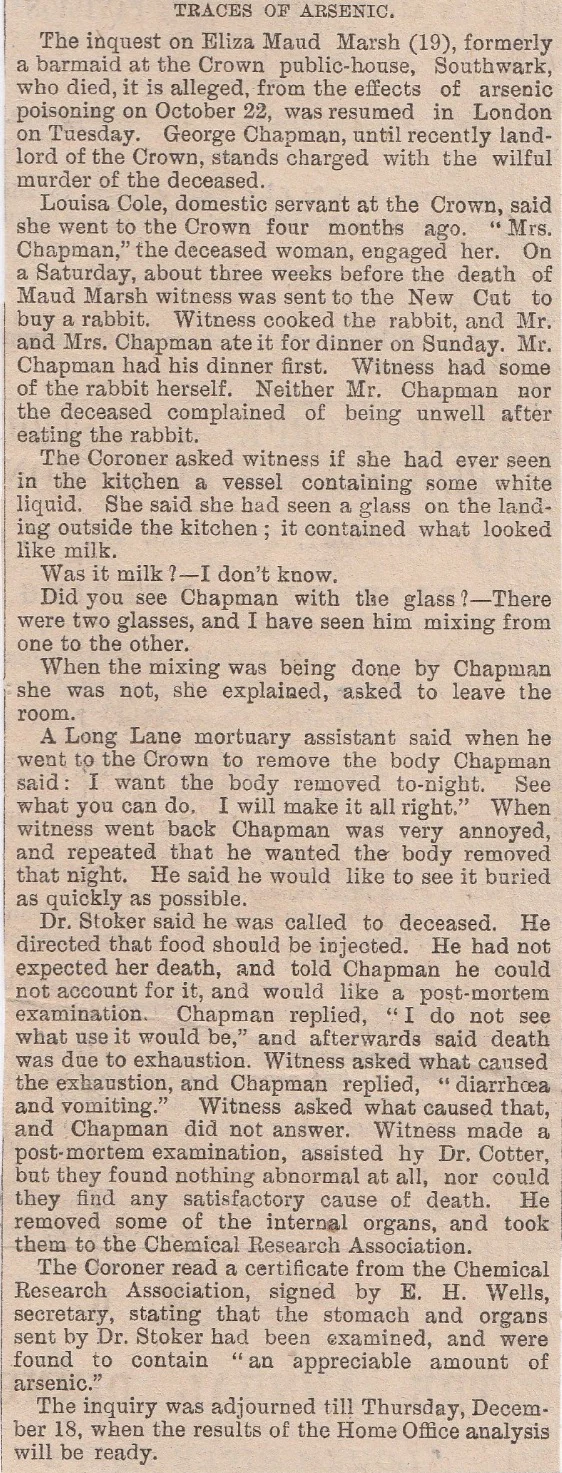
70/ Cock Tavern, Camberwell March 1877 (Cock Tavern- No 3, Denmark Hill) Potman- Glass Collector
A nineteen-year-old Suffolk lass named Ellen Gissing, who was a barmaid at The Cock Tavern in Camberwell was found by the landlord, Henry Kennet, dying in her room from poisoning herself. A doctor and police were sent for but she died five minutes after he turned up, as he stated by strychnine poisoning. He asked her if she had taken anything, she replied “poison”, and when he pressed her as to why, she responded “Oh, I am in such trouble. I have been ruined by the potman and he has threatened to kill me. I am dying. I wish to die, for I am in such frightful pain”. On her person were some “Battle’s Vermin Killer”. The mother came from Suffolk to view the body and said she had a letter from the landlady, Mrs Kennet, who asked her to come to Camberwell as her daughter was threatening “to make away with herself”. The Coroner pointed out that the potman was not needed at the inquest, to which Mrs Gissing, her mother shouted: “For God’s sake, don’t bring him where I am, gentlemen, I couldn’t bear to look at him”.
71/ Denmark Hill Station Suicide, September 1883
Just a few yards from Denmark Hill Station, a body of a man was found in a tunnel, horribly mangled by a passing train. The porter, George Ashdown, found him while walking through the tunnel on the west side of the station at midnight. He was about twenty yards down when he tripped over the corpse, which was missing one side of his face and had an arm missing, which lay nearby. There were various trinkets and bits and bobs in his pockets, but what got the police interested was an address saying “Miss Sporle, No24, St Georges Street, Peckham”. It turned out to be his girlfriends’ address and she identified him as Alfred Pound aged twenty-one, and also from Peckham. Miss Sporle said that a few days ago he had asked her a strange question, which she thought he was joking about, and it was “What is the easiest way out of this world”. He told her he would shoot himself on a train line, then fall on the tracks and let the engine run over him just to make sure. The Derringer pistol found next to the body belonged to Pound. He tried to follow his plan and shoot himself, then fall on the line, but it just severed his arm off and didn’t slice him in two as he’d hoped.
72/ Dulwich/Camberwell Child Murder, December 1st, 1885 (Could be Southwark or Lambeth)

73/ Dulwich/Camberwell Child Murder, December 8th, 1885

74/ Dulwich/Camberwell Child Murder, December 19th, 1885
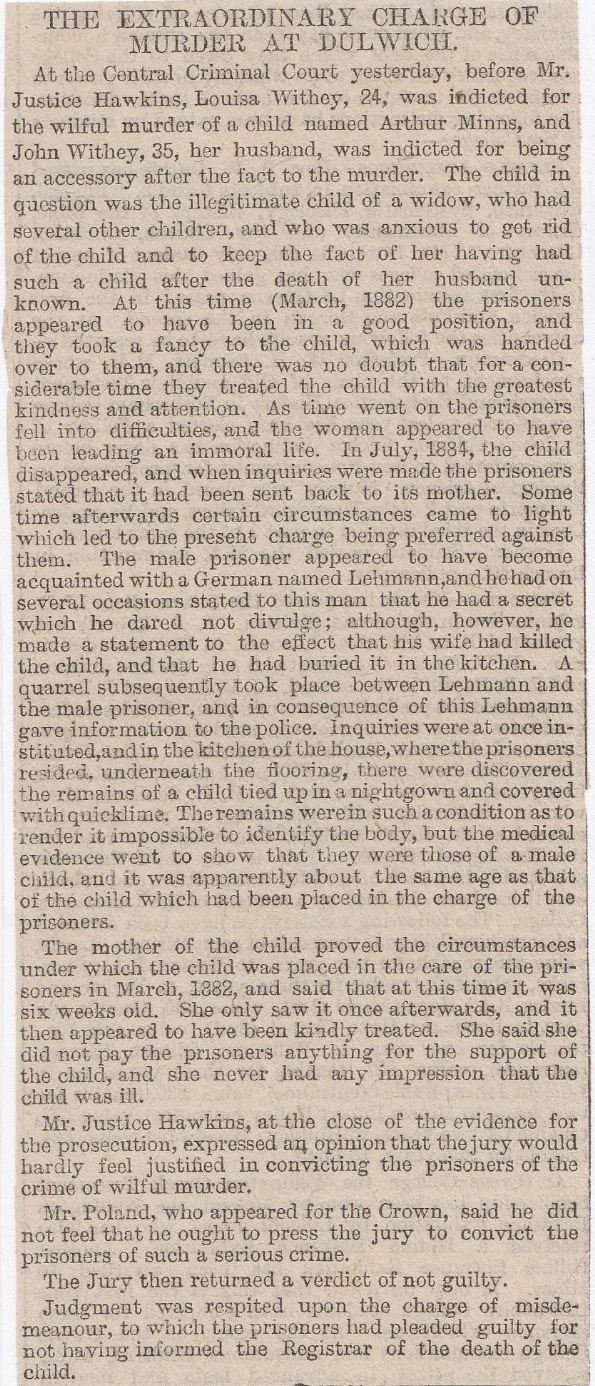
75/ Bermondsey Murder/Suicide, March 1867
A horrible murder and suicide occurred on Wednesday last, in Bermondsey. A householder named Catford was summoned to serve as a juror on an inquest about to be held and on his return, after discharging that duty found that his wife had murdered her only son, about four years old, by nearly severing his head from his body and then had cut her own throat. Both had been dead upwards of an hour. Mrs Catford appeared in her usual health when her husband left home and no cause can be assigned for the dreadful act, but it is said that the deceased was subject to fits of depression and symptoms indicating aberration of intellect.
76/ Westminster Bridge Road (Vitriol Throwing) September 1870.
77/ Camberwell Child Murder, August 1870.
78/ Camberwell Wife Murder, August 1870. In another publication, the address was Meeting House Lane in Peckham.
79/ Church Street, Rotherhithe (Fatal Fire) August 29th, 1870
August 31st 1870.
Yesterday Mr Carter, coroner for Surrey, resumed the inquest on the bodies of the two Dinnes, father and son, who perished in the Church Street fire in Rotherhithe. All the material facts connected with the calamity, as elicited on the first day of the inquest, and still further on Saturday last, at that held at Guy’s Hospital on the body of Henry Welsh, 20, who died from injuries received in jumping from a second-floor window of the burning building. In the case of the two Dinnes, the jury arrived at the conclusion, in effect, that they were suffocated and burnt, but how the fire originated there was no direct evidence to show.
80/ Murder in Dover Road, Southwark. September 1870.
81/ Body Found near Horselydown (Bermondsey) November 1870.
82/ Body in a Carriage at London Bridge Station, November 1870 (London Bridge Station is next to The Shard)
83/ The Borough Poisoner, George Chapman. (Newspaper clippings- See also No. 69) December 13th, 1902
December 20th, 1902 (Maud Marsh Poisoning)
Saturday, January 3rd, 1903
Chapman, the Southwark publican, who is charged with poisoning his barmaid, Maud Marsh, was again brought up in court on Wednesday and charged with murdering his two alleged wives as well. The case for the prosecution was fully developed. Chapman, it is stated, is a Russian Pole, and has some medical training. The bodies of the two women exhumed were found to contain antimony. Prisoner was again remanded.
84/ Southwark Poisoning Case (George Chapman) January 10th, 1903.
85/ The Borough Poisoner, January 26th, 1903. (Newspaper Article)
86/ Camberwell Murder/Suicide, Albany Road. August 1903.
87/ Armenian Murders at Peckham Rye, November 10th, 1903.
Armenian Murders at Peckham Rye, November 13th, 1903 (The Funerals)
88/ Bermondsey Wife Murder, October 1904 ( Off Jamaica Road)

89/ Dulwich Shooting Case, Railway Mews. October 1906
90/ Fatal Fire in Bermondsey Street, Bermondsey. November 17th, 1906
November 21st, 1906.
The inquest of the third victim of the Bermondsey fire, Herbert Deeks, a secret was revealed which had been kept for four years. “Miss Bush” who leapt into the street and so saved her life, sent a certificate which showed she was married to Deeks on August 3rd, 1902. Evidence given showed the place was a death trap. The stock consisted of flannelette, celluloid combs, collars and hat sprays, which, when ignited, went off like “golden rain”. The jury returned a verdict of “Death from burns”, but could not state the cause of the fire.
91/ Murder of Ex-girlfriend, Willow Walk, Bermondsey. October 26th, 1906
November 14th, 1906 (Execution of Frederick Reynolds)
At Wandsworth Gaol on Tuesday, Frederick Reynolds was executed for the murder of Sophia Lovell, at Bermondsey. Reynolds had kept company with the young woman, who broke off the engagement. She became acquainted with another young man, and on the night of September 10th, while she was walking out with him, Reynolds attacked her and cut her throat with a razor. Death resulted in a few minutes. Reynolds, who maintained a careless demeanour at the trial, afterwards showed marked contrition for his crime. He spent a rather restless night but behaved firmly at the last. Pierrepoint was the executioner and death was instantaneous.
92/ Murder of Sister, Walworth. March 16th, 1907
At Lambeth, on Tuesday, Arthur Parker Hawkins, aged thirty-six, labourer, of Great Suffolk Street, Borough, was committed for trial charged with the murder of his married sister, Mary Ann Alpe, at Walworth, on February 23rd. The deceased was fatally stabbed, and the suggestion of the prosecution was that there was strong circumstantial evidence that the prisoner was the man who inflicted the injuries.
Saturday, March 30th, 1907 (Walworth Tragedy)
93/ Murder/Suicide in Evelina Road, Nunhead. September 1907 (Across the road from St Mary’s Road. Still there, No.45, Evelina Road, Nunhead)
